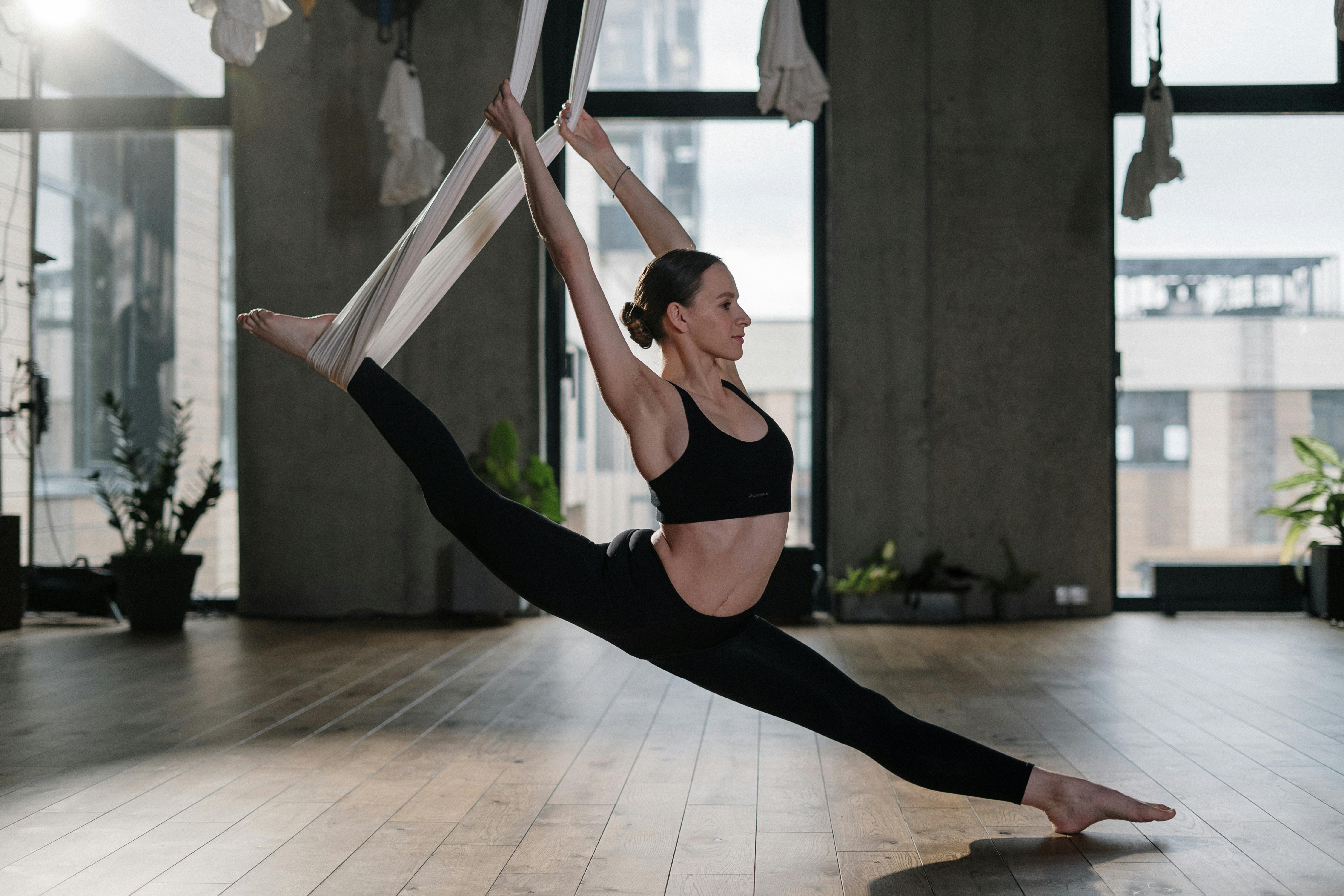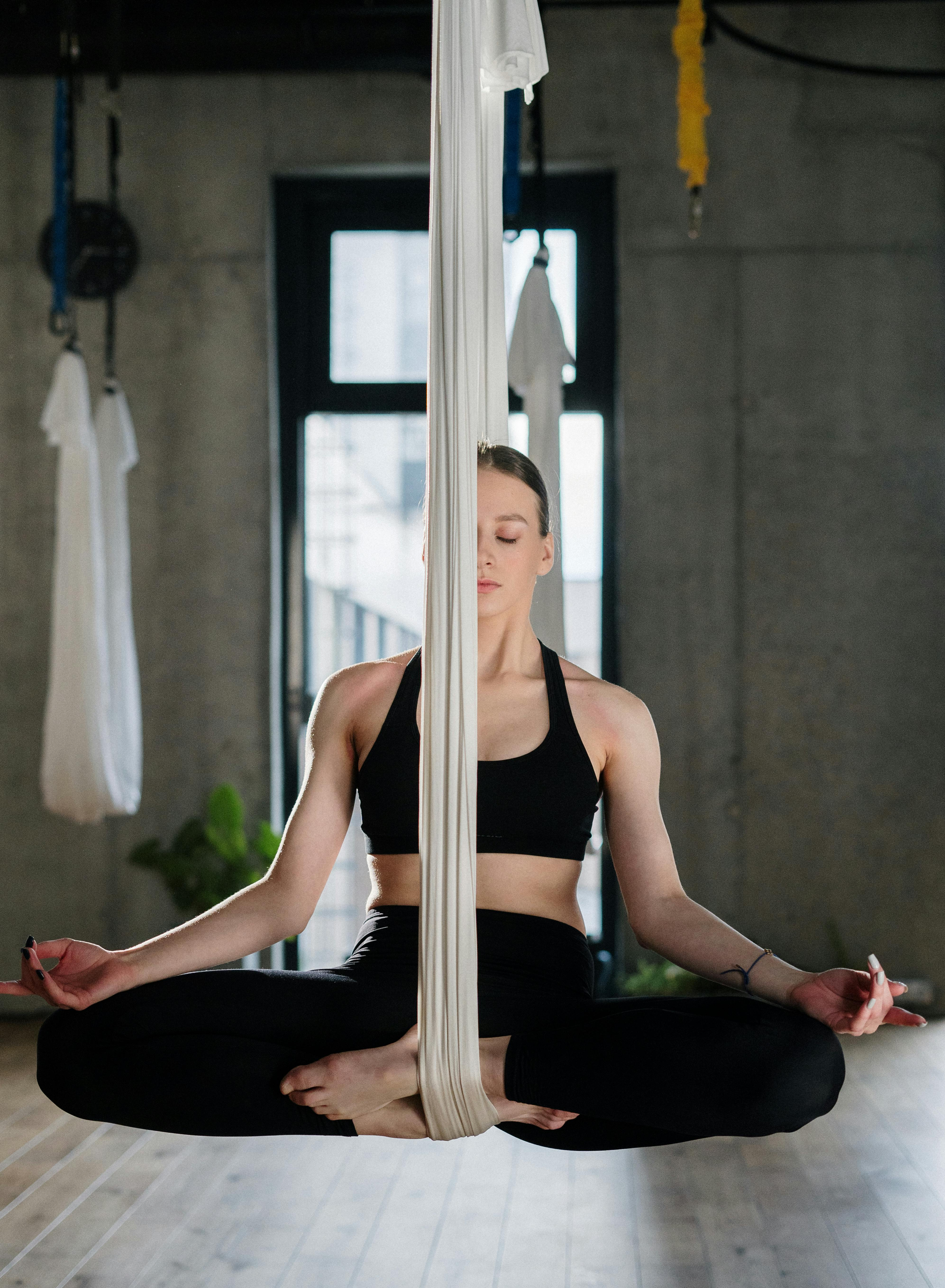Search for yoga retreats
Discover yoga retreats, holidays, and courses from worldwide.
Ever felt the urge to elevate your yoga practice? Look no further than Aerial Yoga, a captivating style that takes your workout to new heights (literally!). Also known as Antigravity Yoga or AG Yoga, it seamlessly blends traditional yoga postures with Pilates and dance elements, all while incorporating a special hammock for support.
Intrigued by the idea of flowing through asanas suspended in mid-air? Imagine basking in breathtaking landscapes while exploring Aerial Yoga at a dedicated retreat – an experience that's both rejuvenating and unforgettable.
What is Aerial Yoga?
In recent years, Aerial Yoga has captured the hearts (and attention) of yogis worldwide. This innovative style combines the familiar asanas found in Vinyasa, Iyengar, or Hatha yoga with the unique twist of using a hammock or swing for support. This allows practitioners to explore challenging poses with greater ease, minimizing pressure on the head, shoulders, and spine.

A Brief History of Aerial Yoga
The exact origins of Aerial Yoga are a matter of some debate. However, B.K.S. Iyengar, a pioneering yoga teacher, is acknowledged for his early use of fabric props. He incorporated hanging upside down with ropes into his teaching to facilitate easier inversions. While not considered a distinct yoga style at the time, it planted the seeds for future innovation.
Fast forward to 1990, Christopher Harrison, a Broadway choreographer and former gymnast, enters the scene. Harrison, known for his work with aerial performances and renowned artists like Mariah Carey and Britney Spears, was also exploring yoga as a way to manage his own injuries. By fusing his aerial expertise with yoga practice, he developed a routine that became the foundation of his Antigravity fitness program – what we now know as Aerial Yoga.
Initially, Aerial Yoga was only accessible in major cities like L.A. and New York. Today, however, it's widely available across the globe. While some opt for home practice with personal hammocks, for beginners, guidance from a qualified instructor is crucial to ensure safety and proper technique.
The Foundation of Flight: Core Elements of Aerial Yoga
Aerial Yoga isn't just about inversions and fancy poses in a hammock. It's a practice built on three fundamental pillars:
- Asanas (Postures): At the heart of Aerial Yoga lie the familiar asanas you might encounter in Vinyasa, Iyengar, or Hatha yoga. The key difference? Performing them with the support of a hammock. This allows for deeper stretches, improved alignment, and exploration of poses that might be challenging on the ground. Think variations of warriors, planks, and even inversions like shoulder stands – all supported by the hammock for a safe and empowering experience.
- Breathwork: Just like in traditional yoga styles, breath control (pranayama) is instrumental in Aerial Yoga. Focusing on your breath helps maintain balance, control your movements, and navigate twists and stretches while suspended in mid-air. Proper breathing keeps you centered and allows you to flow gracefully through the practice.
- Balance and Coordination: Aerial Yoga presents a unique challenge to your balance system. The hammock adds a layer of instability that requires constant core engagement and focus to maintain your equilibrium. As you progress, your balance and coordination will naturally improve, leading to a greater sense of control and confidence in your practice.
Benefits of Aerial Yoga
Aerial Yoga is considered a cardio-intensive yoga practice. A recent study conducted by the American Council on Exercise (ACE) found that women who participated in three 50-minute Aerial Yoga classes per week for six weeks experienced improved stamina and weight loss.
But the benefits extend far beyond the physical. Aerial Yoga is excellent for:
- Muscle and Joint Rehabilitation: The practice promotes healing and improves range of motion.
- Enhanced Balance and Flexibility: Aerial Yoga challenges your balance and encourages deeper stretches.
- Stronger Core: The movements naturally engage your core muscles, leading to increased strength and stability.
- Improved Circulation: The inversions and movements can help boost blood flow.
- Stress Reduction: The playful nature of the practice is a great way to de-stress and unwind.
- Spinal Decompression: The suspended postures can help alleviate back pain by decompressing the spine.
- Confidence Boost: Mastering new poses and overcoming fears can significantly boost your self-esteem.
- Emotional and Psychological Well-being: By stimulating neurotransmitter production, Aerial Yoga can help reduce anxiety and depression, promoting overall happiness.

Open to All Flyers: Exploring Aerial Yoga
Forget the misconception that Aerial Yoga requires acrobat-level flexibility. This practice welcomes beginners! Introductory classes focus on core strength, alignment, and even partner communication (if applicable). With a curious mind and willingness to explore, you'll be surprised by the fun you can have.
Fitness level isn't a barrier either. Aerial Yoga prioritizes technique and teamwork over raw power. Even those new to exercise can experience the joy of flight with proper instruction.
Listen to Your Body: While Aerial Yoga offers amazing benefits, consult your doctor if you have pre-existing conditions like vertigo, heart disease, or severe arthritis. Pregnancy and recent surgery recovery are also considerations.
Packing for Your Aerial Yoga Retreat (What to Bring and What to Leave Behind)
By now, you're probably brimming with excitement to experience Aerial Yoga for yourself. Here's a handy cheat sheet to ensure you pack the essentials and leave unnecessary items at home for your first Aerial Yoga retreat:
Must-Haves for a Blissful Aerial Yoga Experience:
- Comfortable Clothing: Prioritize loose-fitting yet supportive attire. Leggings and long-sleeved tops are ideal, as they provide coverage and prevent friction with the hammock. Opt for breathable fabrics that wick away moisture.
- Grippy Socks: Toe socks or yoga socks offer superior traction, preventing slips while performing poses in the hammock.
- Reusable Water Bottle: Staying hydrated is crucial during any yoga practice. Pack a reusable water bottle to stay refreshed throughout the retreat.
- An Open Mind and Playful Spirit: Embrace the unique experience! Aerial Yoga is all about having fun, exploring new movements, and pushing your boundaries in a safe and supportive environment.
Items to Leave at Home:
- Perfumes and Lotions: These products can stain or weaken the hammocks used in the class. Opt for a natural deodorant if needed.
- Jewelry and Belts: Dangling jewelry or bulky belts can snag or tear the delicate hammock fabric. Leave them at home for safety reasons.
- Bulky Electronics: Disconnect and unwind! Focus on being present in the moment and enjoying the retreat experience. Most retreats offer stunning natural settings, so leave your laptop and other electronics at home (except for your phone to capture those memorable moments!).
Bonus Tip: Pack a light scarf or sarong for extra comfort and versatility. It can be used for warmth during relaxation periods or as a makeshift prop for certain poses.
Final Note: Take Flight and Experience the Magic of Aerial Yoga
Aerial Yoga offers a unique blend of physical challenge, playful exploration, and deep relaxation. It's a chance to defy gravity, reconnect with your body, and discover a newfound sense of joy and accomplishment. So, take a leap of faith, embrace the adventure, and see where Aerial Yoga takes you. You might just surprise yourself with what you can achieve when you take flight!
Craving More Stories?
Join our ShopYogaRetreats newsletter for the latest updates on thrilling
destinations and inspirational tales, delivered straight to your inbox!
We value your privacy. Your email address will never be shared or published.
 English
English Deutsch
Deutsch Français
Français Nederlands
Nederlands Español
Español

